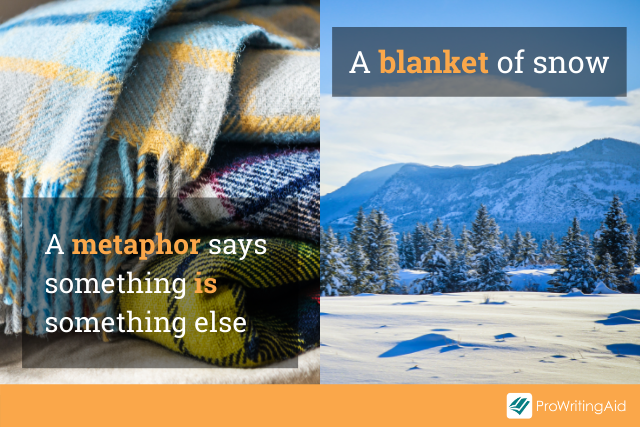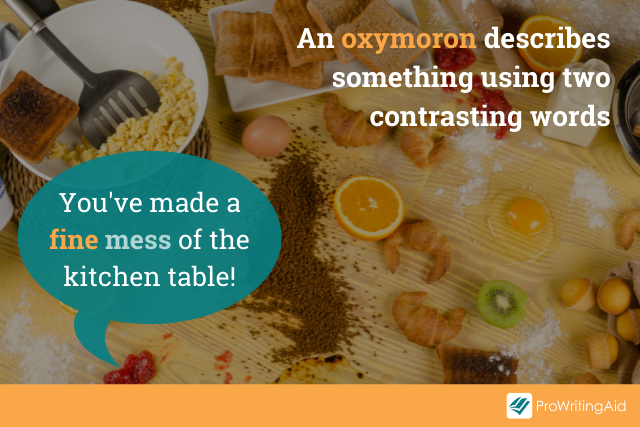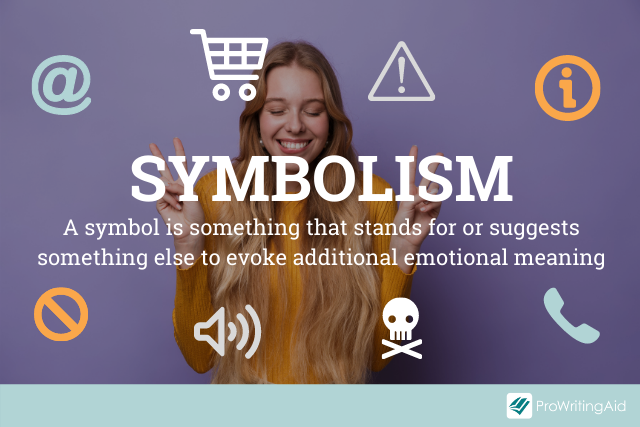
Color Your Writing with Figurative Language
Figurative language means using literary devices, techniques, and figures of speech to heighten sensory response and add meaning, clarity, or impact to your writing.
Figures of speech color your prose, giving a sense of immediacy to readers. They evoke a strong emotional reaction.
Just like a figure in a drawing, figurative language creates an image in your reader’s mind. Figurative language calls on the reader’s senses through sounds, scents, tastes, images, and touch to make an idea accessible.
You probably use figurative language in your everyday speech without thinking twice about it. Here are some examples:
It’s a million degrees outside today.
Alice is busy as a bee.
His smile was a mile wide.
The chair groaned with his weight.
I can help you with your HTML—it’s a piece of cake.
It’s not really a million degrees outside. Alice isn’t a bee. Configuring code is not cake. But that’s how figurative language works. The images (figures) create an immediate impression.
Figurative language has been around as long as people have been telling stories. Over time, writers have come up with many ways to use figurative language. The world is your oyster (see what I did there?) when it comes to choosing figurative ways to express yourself.

22 Examples of Figurative Language
When you want your writing to connect with readers and give them an emotional punch, figurative language can create an immediate response. Perk up your writing using figurative elements.
Here’s an introduction to 22 different ways of how to use figurative language.
1. Simile
A simile compares two things that are unlike each other by using “as” or “like” to establish equivalency. You are saying that the two things are similar.
The imagery is what connects the comparison to the thing you describe. The two things are not related in the world, but the image in the simile describes the state of the item.
Simile examples:
She was like a fish out of water at the prom.
He slept like a dog.
Her eyes sparkled like diamonds.
Figuratively, the man is like a sleeping dog, or the eyes are like diamonds. The figurative language connects the two.
2. Metaphor
A metaphor takes figurative language a step further. There is no comparison; the item described is the image of the metaphor even though it is not literally the object. The figure represents the thing described.

Metaphor examples from everyday speech:
The valley is covered in a blanket of snow.
She has a heart of stone.
He’s the black sheep of the family.
Use metaphors in both prose and poetry to create an emotional connection with your reader.
3. Metonymy
Metonymy means “change of name.” As a literary device, one word is used to replace another closely associated word. Use metonymy to avoid repeating the same word. The representative word allows you to vary expressions or to use a word to express a concept.
Examples of metonymy:
Hollywood: the film industry
Press: journalism and news organizations
Academics: school, college, university, studies
Management: administration, leadership
Metonymy helps keep your writing concise.
4. Synecdoche
A synecdoche uses a part of something to represent the whole. Just like metonymy, it keeps you from overusing a particular word. You’ll expand your reader’s understanding of your topic.
Examples of synecdoche:
Green thumb: a talent for raising plants
Stars and stripes: the American flag
Suit: signifying someone who is in business
5. Personification
Personification attributes human qualities to inanimate objects or the representation of an abstract quality in human form. The best way to understand is to look at some examples.
Examples of personification:
Jim heard the last piece of pie calling his name.
The door protested on its rusty hinges.
The headlights winked as the truck drove through the forest.
Personification makes inanimate objects relatable. It is used in advertising to make a product more approachable. Think of Goldfish crackers: the snack that smiles back.
6. Onomatopoeia
With onomatopoeia, the word itself sounds like the sound you’re describing. Just like a visual figure of speech, the sound of the word makes a vivid connection with the reader.
Examples of onomatopoeia:
The steak sizzled on the fire.
The avalanche boomed across the valley.
The bee and the doorbell buzzed at the same time.
Onomatopoeia is fun figurative language, giving your reader a sensory sizzle and making the scene come alive.
7. Oxymoron
You’ve heard it said that opposites attract. Oxymoron is figurative language that connects two opposite feelings. The words are self-contradicting but build sensory response in your reader by enhancing the concept.

Managing the conference was controlled chaos.
One job qualification for our team is serious fun.
After the party, Kendra found the kitchen in a fine mess.
If you want your oxymoron to hit home, choose your own original opposites. Here’s one from Andy Warhol: "I am a deeply superficial person."
8. Hyperbole
Hyperbolic figurative language goes over the top as an exaggeration for the sake of emphasis, humor, or effect. People use hyperbole often in casual speech.
Examples of hyperbole:
If I hear that one more time, I’m going to die.
After that hike, I am so hungry I could eat a horse.
9. Allusion
An allusion is a brief reference to a person, place, thing, event, or literary/poetic work that the writer assumes the reader knows. Poet T. S. Elliot and novelist James Joyce both wrote using allusions.

Examples of allusion:
Aila’s Achilles’ heel is her squeaky voice when presenting.
Following up with the conference attendees was a Herculean effort.
The cottage by the creek was a perfect Eden.
Be careful using allusions. Match them to your audience. Just because you know something doesn’t mean it is general knowledge, or even knowledge specific to your audience.
10. Idiom
An idiom is an expression using two or more words to refer to something, but the words mean something other than the literal meaning of the words used in the idiom.
Idiomatic phrases can be national or regional. Sometimes even groups or families create their own internal idiomatic expressions.
Example of idiom:
Kirk: “If we play our cards right, we may be able to find out when those whales are being released.”
Spock: “How will playing cards help?”
(Dialogue between characters Captain James T. Kirk and Spock in Star Trek IV: The Voyage Home, 1986)
They are not playing cards. Spock, who takes everything literally, doesn’t understand the idiomatic expression.
Use Figurative Language Wisely by Avoiding Clichés
Be careful when using idioms—they often don’t translate well to non-native speakers (like Spock).
ProWritingAid’s Clichés Report highlights idioms in your writing so you can make sure you’re saying what you really mean.

Some similes and metaphors have become so commonplace that they are now cliché. Use the Clichés Report to find and replace stale words and phrases with fresher ideas.
Ready to freshen up your writing?
11. Imagery
Imagery creates pictures (images) with words. But the imagery is not limited to the visual. Imagery can refer to all five senses and internal emotions.
Examples of touch, taste, and smell imagery:
The rabbit’s fur felt like velvet.
Her lips tasted as sweet as sugar.
The kids rushed inside because the house smelled like chocolate.
Imagery elicits an immediate sensory response in your reader by providing familiar references to help them connect to what you’re saying. Varying the senses you appeal to in your writing makes for a more engaging reader experience.
Use ProWritingAid’s Sensory Report to highlight all of the sensory words in your writing. It will also tell you how many of each type of word you have used so you can make sure you’ve got a good balance.
12. Symbolism
A symbol is something that stands for or suggests something else to evoke additional emotional meaning. A symbol can be a word, object, action, character, or concept. Literary novels often use symbolism to express a theme, like a river representing life.

Examples of symbolism:
Green traffic light: symbolizes “go”
Dollar sign: symbolizes money, wealth, earnings
Shopping cart icon: symbolizes online purchase
You can use anything to symbolize a concept in writing. Just make sure the symbol is one your audience understands.
13. Consonance
Consonance uses consonants in quick repetition. They can appear anywhere in the word—beginning, middle, or end. Consonance not only brings attention to the phrase but makes it easy to remember.

Examples of consonance:
Best bet
Fuddy duddy
Jay-Z uses consonance in “Brooklyn’s Finest,” combining the similar sounds of S and Z.
Peep the style and the way the cops sweat us
The number one question is, can the Feds get us?
Consonance intensifies the language, building an emotional connection with the reader.
14. Alliteration
Alliteration is the use of consonant sounds at the beginning of words close together in a sentence to evoke sensory feelings related to the sound. For example, P and hard C represent excitement, while S represents softness. It isn’t based on the letter but on the sound of the consonant.
Examples of alliteration:
Tonka Trucks
Rocky road
Peter Piper picked a peck of pickled peppers…
As a subset of consonance, use alliteration to call attention to an important point and/or make your point memorable.
15. Assonance
Assonance is the repetition of vowel sounds in words close to each other. Unlike alliteration, where the word starts with a consonant at the beginning, the vowel sound can be inside the word.
Examples of assonance:
Stranger danger
Cock of the walk
Eyes on the prize
Once again, it’s the sound that’s important—not the letter used. And assonance works in the same way as alliteration to make your statement memorable or call attention to it.
16. Irony
Irony is a contradictory statement that expresses a reality different from what appears as truth. It points at a different perspective. In literature, it can be an unforeseen event that changes a character’s expectation or some unanticipated behavior different from what was expected.
Verbal irony is an unanticipated response; situational irony is an unexpected outcome.
Irony examples:
Telling a silent group, “don’t everyone speak at once.” (Verbal irony.)
Marriage counsellor divorcing her third husband. (Situational irony.)
Burglarized police station. (Situational irony.)
Irony also works as a plot device.
Hansel and Gretel (oral tradition): the witch burns in her own oven
Oedipus Rex, Sophocles: Oedipus searches for the murderer, who is himself
17. Sarcasm
Sarcasm is an ironic statement intended to mock. You say something different from what you literally mean. Sarcasm can portray the speaker’s true feelings even though it is veiled in humor. In order for sarcasm to work in writing, you must make sure the context is clear, otherwise the reader will misunderstand.

Examples of sarcasm:
I’d agree with you, but then I’d be wrong.
Ask me if I care.
Aim at nothing, you’ll hit it every time.
18. Litotes
Litotes is a literary device that states an affirmative without using an affirmative word, usually with negative terms. Often used as understatement or negation to express a contrary meaning.
Examples of litotes:
You’re not wrong.
His decision was not the worst.
Your effort has not gone unnoticed.
19. Pun
A pun is a literary device that plays on the sound of words. The words have identical sounds but the meaning is different. Puns are generally intended to be humorous.

Examples of common puns:
The librarian is a bookkeeper.
I need to spend more thyme in the garden.
“The road to success is always under construction.” (Lily Tomlin)
20. Anaphora
Anaphora is the repetition of a word at the beginning of successive clauses, phrases, or sentences. It is figurative language that's especially effective in speeches. It functions to emphasize words and ideas. Use it to evoke emotion, highlight an idea, and create urgency.
Examples of anaphora:
“Go back to Mississippi, go back to Alabama, go back to South Carolina, go back to Georgia, go back to Louisiana, go back to the slums and ghettos of our northern cities, knowing that somehow this situation can and will be changed.” (Martin Luther King Jr.)
“There’s nothing you can do that can’t be done / Nothing you can sing that can’t be sung / Nothing you can say, but you can learn how to play the game” (All You Need is Love, Paul McCartney and John Lennon)
You’re damned if you do and you’re damned if you don’t.
21. Tautology
In figurative language, tautology is the use of two words or phrases that say the same thing. Used well, it emphasizes a point.
But, be careful because tautology can also feel wordy. For example, ProWritingAid will signal tautologies as unnecessary words to keep your writing succinct.
Examples of tautology:
The morning sunrise is beautiful.
“With malice toward none, with charity for all, with firmness in the right as God gives us to see the right.” (Abraham Lincoln)
She was a dark-haired brunette.
22. Understatement
Understatement intentionally makes a statement less important than it seems or is. It functions as the opposite of hyperbole.
Examples of understatement:
“I have to have this operation. It isn’t very serious. I have this tiny little tumor on the brain.” (Catcher in the Rye, J. D. Salinger)
It’s not too bad. (When your borrowed jacket is returned with an indelible stain.)
It’s O.K. I guess. (Describing an incredible result.)
Figurative Language Is the Spice of Writing
Figurative language colors your writing to call attention to a passage. Images, word use, sounds, and wordplay are all ways to spice up your writing whether it’s an article, speech, fiction, or poetry.
Here you have 22 examples as ideas to use when your writing is feeling flat. Match the figurative language to the mood, tone, audience, and intended outcome. You’ll transform the seemingly ordinary into significant writing.



